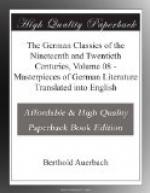Since the days of the Romanticists, since Beethoven, our ear, in the conception of the keys also, has decidedly turned away from the more simple and natural toward the more eccentric. In the keys C-, G-, D-, F-, B-and E-flat major the eighteenth century still found characteristic peculiarities which we are scarcely able to hear at present; to the over-irritated modern ear these simple keys sound flat, colorless, and empty; instead, we have dug our way deeper and deeper among the out-of-the-way keys, and melodies which our fathers made use of only to produce the rarest and strongest emotions have already become the daily bread of our composers.
One can, in the end, escape from this chaos of differing ears only if one accedes to the opinion of old Quantz, the flute teacher of Frederick the Great, who, after an exhaustive argument for and against, comes to the conclusion that in theory nothing can be definitely decided concerning the characters of the keys; in practice, however, the composer is sure to feel that everything does not sound equally well in all keys and therefore must decide each individual case separately, in conformity with his artistic ear and instinct; I will merely add—also in conformity with the ear of his time. For Quantz, by declining to make a theoretical decision, shows that his ear had fallen captive to the Italian musical school which strove not so much to hear the characteristic in music as the simply beautiful, and, indifferent to the prevailing lively controversy over the keys, composed its melodies as was most convenient for the voice of the singer and the fingers of the accompanist.
In the first half of the eighteenth century people still possessed a very keen ear for dance music. The great majority of the dance melodies of that time are moderately animated. To our modern ear and pulse-beat, on the contrary, slow dance music seems to be a contradiction in itself; a melody which in those days inspired people and started their feet to dancing would now lull us to sleep. We desire stormily exciting dance music; our ancestors gave the preference to the gayly stimulating kind. How entirely differently constituted, how differently qualified historically, politically, and socially, was that generation in whose ears sounded the dance rhythm of the majestic sarabande, the solemnly animated entree, loure, and chaconne, the delicate pastoral musette, the staid gliding siciliano, and the measured, graceful minuet, compared to a generation who dance the whirling waltz, the stormy skipping galop, and the furious cancan! In the opera the tragic hero could dance a sarabande, and even in choral songs of the church the ear of the eighteenth century could distinguish dance music. Matheson made (1739) out of the choral song “When we are in dire distress” a very danceable minuet; out of “How beautifully upon us shines the morning star” a gavotte; out of “Lord Jesus Christ,




